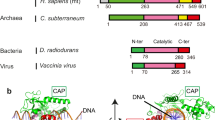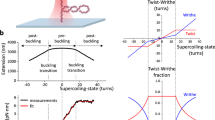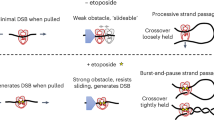Abstract
Topoisomerases are enzymes that are involved in maintaining the topological state of cellular DNA. Their dynamic characteristics remain poorly understood despite numerous structural, biophysical and biochemical studies. Recent single-molecule experiments revealed that an important feature of the type IA topoisomerase mechanism is the presence of pauses between relaxation events. However, these experiments could not determine whether the protein remains DNA bound during the pauses or what relationship may exist between protein domain movements and topological changes in the DNA. By combining two orthogonal single-molecule techniques, we found that E. coli topoisomerase I constantly changes conformation when attempting to modify the topology of DNA, but succeeds in only a fraction of the attempts. Thus, its mechanism can be described as a series of DNA strand-passage attempts that culminate in a successful relaxation event.
This is a preview of subscription content, access via your institution
Access options
Access Nature and 54 other Nature Portfolio journals
Get Nature+, our best-value online-access subscription
$29.99 / 30 days
cancel any time
Subscribe to this journal
Receive 12 print issues and online access
$189.00 per year
only $15.75 per issue
Buy this article
- Purchase on Springer Link
- Instant access to full article PDF
Prices may be subject to local taxes which are calculated during checkout





Similar content being viewed by others
References
Schoeffler, A.J. & Berger, J.M. DNA topoisomerases: harnessing and constraining energy to govern chromosome topology. Q. Rev. Biophys. 41, 41–101 (2008).
Baker, N.M., Rajan, R. & Mondragón, A. Structural studies of type I topoisomerases. Nucleic Acids Res. 37, 693–701 (2009).
Lima, C.D., Wang, J.C. & Mondragón, A. Three-dimensional structure of the 67K N-terminal fragment of E. coli DNA topoisomerase I. Nature 367, 138–146 (1994).
Perry, K. & Mondragón, A. Structure of a complex between E. coli DNA topoisomerase I and single-stranded DNA. Structure 11, 1349–1358 (2003).
Tan, K. et al. Structural basis for suppression of hypernegative DNA supercoiling by E. coli topoisomerase I. Nucleic Acids Res. 43, 11031–11046 (2015).
Changela, A., DiGate, R.J. & Mondragón, A. Structural studies of E. coli topoisomerase III-DNA complexes reveal a novel type IA topoisomerase-DNA conformational intermediate. J. Mol. Biol. 368, 105–118 (2007).
Li, Z., Mondragón, A. & DiGate, R.J. The mechanism of type IA topoisomerase-mediated DNA topological transformations. Mol. Cell 7, 301–307 (2001).
Dekker, N.H. et al. The mechanism of type IA topoisomerases. Proc. Natl. Acad. Sci. USA 99, 12126–12131 (2002).
Hwang, H., Kim, H. & Myong, S. Protein-induced fluorescence enhancement as a single molecule assay with short distance sensitivity. Proc. Natl. Acad. Sci. USA 108, 7414–7418 (2011).
Stennett, E.M., Ciuba, M.A., Lin, S. & Levitus, M. Demystifying PIFE: the photophysics behind the protein-induced fluorescence enhancement phenomenon in Cy3. J. Phys. Chem. Lett. 6, 1819–1823 (2015).
Lang, M.J., Fordyce, P.M., Engh, A.M., Neuman, K.C. & Block, S.M. Simultaneous, coincident optical trapping and single-molecule fluorescence. Nat. Methods 1, 133–139 (2004).
Comstock, M.J. et al. Protein structure. Direct observation of structure-function relationship in a nucleic acid-processing enzyme. Science 348, 352–354 (2015).
Cordova, J.C., Das, D.K., Manning, H.W. & Lang, M.J. Combining single-molecule manipulation and single-molecule detection. Curr. Opin. Struct. Biol. 28, 142–148 (2014).
Graves, E.T. et al. A dynamic DNA-repair complex observed by correlative single-molecule nanomanipulation and fluorescence. Nat. Struct. Mol. Biol. 22, 452–457 (2015).
Fan, J., Leroux-Coyau, M., Savery, N.J. & Strick, T.R. Reconstruction of bacterial transcription-coupled repair at single-molecule resolution. Nature 536, 234–237 (2016).
Kemmerich, F.E. et al. Simultaneous single-molecule force and fluorescence sampling of DNA nanostructure conformations using magnetic tweezers. Nano Lett. 16, 381–386 (2016).
Kirkegaard, K. & Wang, J.C. Bacterial DNA topoisomerase I can relax positively supercoiled DNA containing a single-stranded loop. J. Mol. Biol. 185, 625–637 (1985).
Strick, T.R., Allemand, J.F., Bensimon, D., Bensimon, A. & Croquette, V. The elasticity of a single supercoiled DNA molecule. Science 271, 1835–1837 (1996).
Sissi, C. & Palumbo, M. Effects of magnesium and related divalent metal ions in topoisomerase structure and function. Nucleic Acids Res. 37, 702–711 (2009).
Schmidt, B.H., Burgin, A.B., Deweese, J.E., Osheroff, N. & Berger, J.M. A novel and unified two-metal mechanism for DNA cleavage by type II and IA topoisomerases. Nature 465, 641–644 (2010).
Terekhova, K., Gunn, K.H., Marko, J.F. & Mondragón, A. Bacterial topoisomerase I and topoisomerase III relax supercoiled DNA via distinct pathways. Nucleic Acids Res. 40, 10432–10440 (2012).
Collins, T.R., Hammes, G.G. & Hsieh, T.S. Analysis of the eukaryotic topoisomerase II DNA gate: a single-molecule FRET and structural perspective. Nucleic Acids Res. 37, 712–720 (2009).
Martínez-García, B. et al. Topoisomerase II minimizes DNA entanglements by proofreading DNA topology after DNA strand passage. Nucleic Acids Res. 42, 1821–1830 (2014).
Basu, A., Parente, A.C. & Bryant, Z. Structural dynamics and mechanochemical coupling in DNA gyrase. J. Mol. Biol. 428, 1833–1845 (2016).
Gosse, C. & Croquette, V. Magnetic tweezers: micromanipulation and force measurement at the molecular level. Biophys. J. 82, 3314–3329 (2002).
Meeker, D.C. Finite Element Method Magnetics, Version 4.2 (http://www.femm.info 25 August 2013).
Axelrod, D. Total internal reflection fluorescence microscopy in cell biology. Methods Enzymol. 361, 1–33 (2003).
Perry, K. & Mondragón, A. Biochemical characterization of an invariant histidine involved in Escherichia coli DNA topoisomerase I catalysis. J. Biol. Chem. 277, 13237–13245 (2002).
Joo, C. & Ha, T. Preparing sample chambers for single-molecule FRET. Cold Spring Harb. Protoc. 2012, 1104–1108 (2012).
Burnham, D.R., De Vlaminck, I., Henighan, T. & Dekker, C. Skewed brownian fluctuations in single-molecule magnetic tweezers. PLoS One 9, e108271 (2014).
Skoko, D., Wong, B., Johnson, R.C. & Marko, J.F. Micromechanical analysis of the binding of DNA-bending proteins HMGB1, NHP6A, and HU reveals their ability to form highly stable DNA-protein complexes. Biochemistry 43, 13867–13874 (2004).
Swoboda, M. et al. Enzymatic oxygen scavenging for photostability without pH drop in single-molecule experiments. ACS Nano 6, 6364–6369 (2012).
Senavirathne, G. et al. Widespread nuclease contamination in commonly used oxygen-scavenging systems. Nat. Methods 12, 901–902 (2015).
Acknowledgements
We thank members of the Mondragón and Marko laboratories for discussions and assistance and K. Terekhova for early work on the project. We acknowledge the help from the Keck Biophysics Facility and the Northwestern University Instrument Shop. This work was supported by the US National Institutes of Health (A.M., grant R01-GM051350, and J.F.M., grants R01-GM105847 and U54-CA193419 (CR-PS-OC) and subcontract to U54DK107980) and by the National Science Foundation (J.F.M., grant DMR-1206868). K.H.G. was supported by a Dr. John N. Nicholson Fellowship and a NRSA pre-doctoral training grant (T32-GM008382).
Author information
Authors and Affiliations
Contributions
K.H.G., J.F.M. and A.M. planned the experiments, designed the MT-TIRF microscope, analyzed data and edited the manuscript. K.H.G. and A.M. constructed the MT-TIRF microscope and wrote the manuscript. A.M. wrote the MT-TIRF software. K.H.G. prepared reagents and collected data.
Corresponding author
Ethics declarations
Competing interests
The authors declare no competing financial interests.
Integrated supplementary information
Supplementary Figure 1 MT-TIRF microscope schematic.
A 735 nm LED is mounted above a 710 nm long-pass filter and a pair of magnets. These components can be rotated to introduce supercoils or translated to vary the force applied to the magnetic beads located in the flow cell. An objective-type TIRF microscope with a 561 nm green laser is used to illuminate the flow cell. The infrared and fluorescence data are separated by a 720 nm short-pass dichroic mirror, which reflects the infrared data to a CMOS camera. The CMOS camera is used to track the magnetic bead and, thus, monitor DNA topology. The fluorescence data passes through the dichroic and a 694 nm short-pass filter to enter an EMCCD camera, which is used to track fluorescence intensity for analysis of PIFE. This combination of filters and dichroic prevent any cross-contamination between channels. The EMCCD and CMOS cameras are connected to the same computer and the data are time-stamped to allow for direct comparison of the two channels.
Supplementary Figure 2 Examples of aligned MT and fluorescence data traces.
a) The upper trace of the MT data presents the raw data (converted from extension (μm) to excess linking number) in gray dots. A 100-point boxcar average of the MT data is in red. The lower trace shows the fluorescence data with the raw data in gray and a 10-point boxcar average in purple. The green line at ≍12.4 AU fluorescence intensity represents the middle of the Gaussian fit for control data taken without protein (this is the same fluorescent substrate as in Fig. 2c and Supplementary Figs. 4 and 5, but showing a different time interval). Fluorescence intensity lower than the green line are not considered to be PIFE and are likely the result of the protein unbinding or possibly Cy3 blinking events. Relaxation events are marked by vertical dotted lines and correspond to PIFE spikes (local maxima above 14 AU). One relaxation event in this trace was determined to be uncorrelated as there are no local maxima exceeding 14 AU within 600 ms of the relaxation event (yellow triangle). The low fluorescence intensity during this relaxation event may be a result of Cy3 blinking or the event happened too quickly to be detected with 60 ms imaging. b) Arranged as the traces described in a, this trace is for a different DNA substrate and, hence, the fluorophore has a different no-PIFE (unbound EcTopoI) value, corresponding to ≍10.4 AU (green line). This value was determined from the control data, as was the local maxima cut-off of 12 AU. Only local maxima above 12 AU are considered to be PIFE spikes for this trace. Collection for this trace ended with a fluorophore bleaching event, indicated by a yellow star. These are representative traces from 12 total traces collected from n=9 molecules.
Supplementary Figure 3 Fluorescently labeled EcTopoI present during relaxation events.
a) Magnetic tweezer relaxation trace for the 22nt Cy3 bulge DNA substrate, with the raw data in light gray, overlaid with the 100-pt boxcar average (red) and the step-finding program (Arunajadai, S.G. et al., PLoS One, 8, e59279, 2013) results (navy). b) Concurrent fluorescent trace showing fluorescently labeled wild type EcTopoI non-specifically labeled with Alexa Fluor 555 (data representative of n=3 molecules). The Cy3 attached to the DNA had already been bleached when this trace was taken, so only the fluorescence from the protein is seen. This directly indicates that the protein is present on the DNA during the relaxation process. The protein either bleaches or dissociates at the end of the trace, indicated by the yellow star. c) The histogram of the fluorescence prior to the protein bleaching or dissociating shows that it has a Gaussian distribution, which is different from the distributions seen when the DNA is labeled, as PIFE is not observed in this case.
Supplementary Figure 4 Control fluorescence comparison for Figure 2c.
a) Prior to adding EcTopoI for data collection, the fluorescence of the DNA substrate was measured after the DNA tether was supercoiled (this is the same DNA seen in Fig. 2c). The intensity values of the control data were graphed in a histogram (below) and fitted to a single Gaussian distribution. The center of the Gaussian fit (12.4 AU) was used to set a value for the protein unbound (no PIFE) state for the trace in Figure 2c (green line). The right edge of the Gaussian (14 AU) was set as the limit for identifying local maxima, which correspond to the PIFE spikes. Local maxima below 14 AU were not considered PIFE spikes. b) The distribution of the fluorescence intensities from the fluorescent Figure 2c are shown, with the corresponding histogram of the values below. The histogram shows what are possibly multiple distributions, commonly seen when EcTopoI is present, including a high intensity shoulder that is associated with PIFE spikes.
Supplementary Figure 5 Step-detection and PIFE spike assignment.
a) The figure shows the same traces as in Figure 2c. The concurrently collected MT (top) and fluorescence intensity (bottom) traces were aligned in time. To illustrate further how relaxation steps are analyzed in the MT traces, the dark blue line overlaying the red 100 point boxcar average shows steps identified using a step-finding program (Arunajadai, S.G. et al., PLoS One, 8, e59279, 2013). This program does not always provide accurate step identification as it assumes sharp step transitions, which is not common in relaxation events. For this reason, in addition to using the program, the 100-point boxcar average was used to assign the relaxation steps. b) Expanded section of the fluorescence trace marked by the box labeled b. The PIFE spikes can be seen more clearly. Black crosses indicate local maxima identified by automatic identification using Origin (5 point window) (OriginLab, Northampton, MA). The vertical dotted black lines mark relaxation events. When the local maxima and relaxation events are within 600 ms, they are considered correlated (Supplementary Note 1). The light blue boxes indicate the 600 ms window on either side of the local maxima. Visual inspection shows that while the relaxation events do not always align exactly with the local maxima, they fall within the spike of fluorescence associated with the local maxima. This is probably due to the inexact identification of the start of a relaxation event. However, Figure 3c illustrates that on average the PIFE spikes are centered on relaxation events. c) A second section of the fluorescence trace, corresponding to the box labeled c, is shown to illustrate further the correlation of PIFE spikes and relaxation events.
Supplementary Figure 6 EcTopoI frequently unbinds when magnesium is not present.
a) When no EcTopoI is present in a magnesium free buffer the fluorescence intensity of the 22nt Cy3 bulge DNA shows a single Gaussian distribution. b) When protein in magnesium free buffer is added to the same DNA as in a, multiple binding and unbinding events are observed. This extended unbinding was often seen for the 22nt Cy3 bulge DNA substrate. Some exceptions where the protein remained bound for longer time periods were observed (Fig. 4b). The fluorescence from bound and unbound states can be modeled by two Gaussian distributions, each corresponding to a single state. There is no asymmetry in the bound state Gaussian distribution and also no high intensity fluorescence associated with PIFE spikes. Representative data from a total of n=9 DNA molecules.
Supplementary Figure 7 Type IA topoisomerase mechanism on fluorescent substrate.
a) Prior to EcTopoI binding to the fluorescent DNA substrate, the Cy3 fluorophore has a low fluorescence intensity. After binding the fluorescence intensity increases due to the protein binding in close proximity to the fluorophore, this fluorescence intensity increase indicates PIFE and represents the protein bound state. b) While EcTopoI is bound, fluorescence intensity fluctuations were observed, which could correspond to domain movements. c) When EcTopoI creates the transient phosphotyrosine linkage, it effectively tethers the Cy3 molecule on the 3’ end of the DNA to domain III. The presence of magnesium, which stimulates DNA cleavage and active site conformational changes, allows domain III to move down and to the side of the protein, opening a gate to allow for capture of the uncleaved DNA strand. This moves the Cy3 molecule closer to the protein, further increasing fluorescence above the bound state PIFE, to what we term a PIFE spike. d) PIFE spikes are short lived and the majority of domain movements for this 22nt Cy3 bulge DNA substrate do not lead to productive relaxation events, so domain III returns to its previous position and fluorescence returns to the bound PIFE state. e) This cycle can be repeated many times before the uncleaved ssDNA is in the correct orientation to be successfully captured. f) After capture of the ssDNA, the protein is able to move the uncleaved DNA through the transient break and religate. g) After the protein releases the captured strand, it is ready to start a new cycle.
Supplementary information
Supplementary Text and Figures
Supplementary Figures 1–7, Supplementary Tables 1 and 2, and Supplementary Note (PDF 1887 kb)
Source data
Rights and permissions
About this article
Cite this article
Gunn, K., Marko, J. & Mondragón, A. An orthogonal single-molecule experiment reveals multiple-attempt dynamics of type IA topoisomerases. Nat Struct Mol Biol 24, 484–490 (2017). https://doi.org/10.1038/nsmb.3401
Received:
Accepted:
Published:
Issue Date:
DOI: https://doi.org/10.1038/nsmb.3401
This article is cited by
-
Duplex DNA and BLM regulate gate opening by the human TopoIIIα-RMI1-RMI2 complex
Nature Communications (2022)
-
Direct observation of topoisomerase IA gate dynamics
Nature Structural & Molecular Biology (2018)



